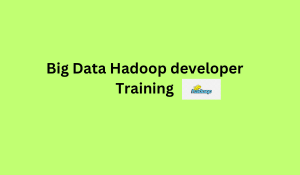What is Big Data?
Big Data refers to extremely large and complex datasets that traditional data processing tools struggle to manage. It involves processing, analyzing, and deriving insights from massive volumes of structured and unstructured data, often in real-time, to uncover valuable information and patterns for decision-making.
Explain the key components of the Hadoop ecosystem.
The Hadoop ecosystem include of key components, including HDFS for distributed storage, MapReduce for parallel processing, and YARN for resource management. Additional components like Hive, Pig, HBase, and Spark boost functionality, enabling tasks like data querying, scripting, NoSQL storage, and in-memory data processing, creating a comprehensive framework for Big Data analytics.
What is the Hadoop Distributed File System (HDFS)?
Hadoop Distributed File System is a distributed storage system designed to store and manage large volumes of data across multiple nodes in a Hadoop cluster. It breaks data into blocks, replicates them across nodes, and enables parallel processing, upgrade fault tolerance and scalability for big data applications.
Can you describe the role of the NameNode and DataNode in HDFS?
In HDFS, the NameNode is the master server that manages metadata, keeping track of file locations and structure. DataNodes are slave servers that store actual data blocks. The NameNode instructs DataNodes on block placement, ensuring redundancy. If the NameNode fails, data recovery is possible through replicated copies stored by DataNodes.
What is MapReduce, and how does it process data in Hadoop?
MapReduce is a programming model for processing and generating large datasets in parallel across a distributed Hadoop cluster. It consists of two phases: the Map phase processes input data, and the Reduce phase assemblage and summarizes the results, enabling scalable and efficient data processing.
Explain the purpose of YARN (Yet Another Resource Negotiator) in the Hadoop ecosystem.
YARN (Yet Another Resource Negotiator) in the Hadoop ecosystem manages and schedules resources efficiently for distributed processing. It separates cluster resource management from job execution, allowing multiple applications to share resources dynamically. YARN enhances scalability, resource utilization, and supports various processing engines, making Hadoop more versatile for diverse workloads.
Describe the key features of HBase.
HBase is a NoSQL database within the Hadoop ecosystem. Its key features include column-family-based storage, automatic sharding for scalability, strong consistency, and fault tolerance. HBase supports real-time data access, making it suitable for handling large-scale, sparse datasets with high read and write throughput necessities.
Explain the use cases where HBase is a suitable choice.
HBase is suitable for use cases needing real-time, random admission to large datasets, especially in scenarios with high write and read frequency. It excels in applications such as time-series data, monitoring systems, and situations demanding low-latency, and distributed storage.
What is Apache Spark?
Apache Spark is an open-source distributed computing system designed for fast and general-purpose data processing. It supports various programming languages and excels in large-scale data analytics and machine learning, offering high-performance and fault-tolerance for processing big data tasks.
Differentiate between MapReduce and Apache Spark.
MapReduce and Apache Spark are distributed computing frameworks. While MapReduce processes data in discrete steps with data stored on disk, Spark keeps intermediate data in memory, enabling iterative and interactive analytics. Spark also offers higher-level abstractions, like DataFrames, making it more expressive and suitable for a broader range of applications than MapReduce.
How would you ingest data into the Hadoop ecosystem?
To ingest data into the Hadoop ecosystem, one can use tools like Apache Flume, Apache Sqoop, or Apache Kafka. Flume assists spouting data ingestion, Sqoop facilitates the transfer of structured data from relational databases, and Kafka supports real-time data streaming for distributed processing in Hadoop.
Discuss the advantages and disadvantages of different data ingestion methods.
Advantages of data ingestion methods include HDFS commands for simplicity, Flume for real-time streaming, Sqoop for database integration, and Kafka for fault-tolerant real-time streaming. Disadvantages may include complexity with Flume and potential performance issues with Sqoop in large-scale data transfers. Choosing the method depends on specific use cases and requirements.
What are the security considerations in a Hadoop cluster?
Security in a Hadoop cluster involves considerations like authentication using tools such as Kerberos, authorization with access controls, encryption for data at rest and in transit, and auditing to monitor and track user activities. Properly configured security measures help protect sensitive data and ensure a secure Hadoop environment.
Explain how Kerberos is used for authentication in Hadoop.
Kerberos is a network authentication protocol used in Hadoop for secure user authentication. It gives a centralized authentication server, issuing tickets to users, permitting them to access Hadoop services securely across the cluster.
How can you optimize the performance of a Hadoop cluster?
Optimizing Hadoop cluster performance involves adjusting configuration parameters, such as block size and replication factor. Utilize compression, choose appropriate storage formats, and optimize data placement. Implement efficient resource management using tools like YARN, Ambari, and fine-tune cluster hardware for optimal throughput.
How would you troubleshoot performance issues in a Hadoop cluster?
To troubleshoot Hadoop cluster performance, monitor resource usage, examine log files, and leverage tools like Hadoop Metrics and Ganglia. Identify and address bottlenecks, optimize configurations, and use profiling tools to analyze MapReduce jobs, ensuring efficient cluster operation.
Discuss the challenges and solutions for real-time processing in the Hadoop ecosystem.
Real-time processing in the Hadoop ecosystem faces challenges like latency, complexity, and scalability. Solutions incorporate adopting technologies like Apache Storm or Apache Flink for stream processing, enhancing data pipeline architectures, and implementing strategies for efficient data absorption and storage to assure timely and dependable processing.
How do you handle node failures in a Hadoop cluster?
In a Hadoop cluster, node failures are managed through mechanisms like data replication and fault tolerance. HDFS (Hadoop Distributed File System) replicates data across nodes, ensuring redundancy. Hadoop’s resource manager, along with task trackers, detects and redistributes tasks affected by node failures, maintaining cluster reliability.










